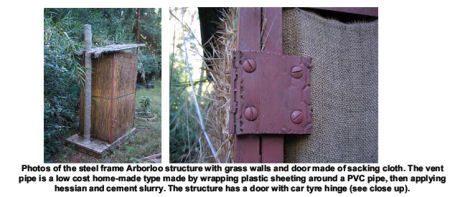Ingenuity, obviously, isn’t only limited to the African continent, as it is especially found in societies where access to resources is limited. While we’ve been able to witness lots of interesting innovations from other regions of the world that were born out of a lack of readily available solutions, we must also not forget that a few smart ideas were actually developed in Africa and have since then conquered the world.
One of such smart ideas is the Ventilated (Improved) Pit Latrine, in short: the VIP – which was developed as the “Blair Latrine” by Peter Morgan, who has been living and working in Zimbabwe for over 35 years, researching and developing water and sanitation technologies.

Diagram showing effect of vent pipe on functions of pit latrine (source)
The major advantage of the VIP over a normal pit latrine is that it comes with a ventilation pipe (covered with a durable fly screen on top) which reduces flies and odour. In the absence of other alternatives, the Ventilated Pit Latrine is considered reliable, which explains the success of this technology: over 500.000+ units of this type have been built in Zimbabwe alone and it has proven to work elsewhere around the world.
The VIP clearly isn’t the solution to sustainable sanitation as it comes with a few limitations, but it does function without water and has very low investment, operation and maintenance costs.
Next to some interesting experiments with different water pump systems such as the Blair hand pump (also known as the Zimbabwe Bush Pump) or the spiral water wheel pump, Peter is also active in the field of ecological sanitation and recently published a very interesting booklet titled “Toilets That Make Compost” where he writes about his experiences with compost toilets such as the Arborloo and the Fossa Alterna.

screenshot from Peter Morgan’s manual on how to build an Arborloo (PDF,~ 3,1MB)
While there’s no single sanitation concept that will work in all places around the world, the VIP for one is a proven technology which has been accepted by its users since 30 years.


I do have the same VIP at home in Dakar ! Are u sure it’s coming from Zimbabwe ? ?
Well – that’s exactly the point: while the concept of a Ventilated Improved Pit latrine (VIP) was initially designed at the Blair Research Laboratory in Zimbabwe in the 1970s, the technology has since then been exported to other countries.
500,000 in just Zimbabwe! Man, that’s a lot. I had no idea that’s where they originally came from either.
By the way, mobile toilets use at construction sites in Germany are build the same way. Only difference is that the pipe is inside the toilet (for no other reason than to make it more compact), and it is painted black.
Due to the black color it heats up and works like a chimney, sucking out all the odor from the toilet itself.
Works great and independent of wind.
Key feature of the Blair is that flies enter thru the door – always open, but curved / offset access – and having fed / laid eggs on faeces, see light at top of pipe rather than thru floor hole, so seek exit that way. They fail because of the GAUZE. Ventilation helps the passege of smell, not really the fly!
The GAUZE separates the faeces from the food. Without gauze, it is a pit latrine – and a health hazard.
To tackle this issue Pump Aid has developed the Elephant Toilet. This is a low cost, technology appropriate design that communities are benefiting from and will continue to do so for many years to come. The Elephant Toilet has won the prestigious St.Andrews Prize for Environment 2008 for best design.
At the doorway of the toilet hangs a water container with a ball point pen barrel inserted near the bottom. To turn on the tap, the lid is taken off the pen, and then replaced to turn it back off. The simplicity of the design means that even the youngest children can learn this process. For soap, a seso bush that has antiseptic qualities is planted outside the toilet. It is watered by the stream of waste water from hand washing.
To combat flies and odour, a plastic bottle with holes punched in for ventilation, is inserted at the top of the chimney. As it heats it creates a convection process, causing a current of air to move through the toilet to help remove the scent of the pit. The light entering through the bottle attracts flies, which are then eliminated by the heat inside.
When the pit is full (and it will take several years) the concrete floor slab is moved to a new pit and a fruit tree is planted on the old one. The fruit it produces will supplement the diet of the local community or can be taken to market to bring much-needed income for the community.
The Elephant toilet costs just £20 to build, including all materials and labour costs, making them a high contender for the cheapest/most effective toilet solutions around.
Pump Aid has been chosen as the UK NGO partner to Live Earth 2010. On April 18th 2010 Live Earth returns, turning its attention and significant influence onto the global water challenge. The Live Earth Run for Water global events on 18th April 2010 will be the single biggest fundraising effort for water causes in history. Nearly 1 billion people across the world do not have access to clean water impacting on poverty and increasing disease – around 4,000 children die every day from dirty water. More than 100 countries across the globe will participate in raising money for water causes by staging 6 kilometer run/walk events. London and Manchester will be hosting the UK events with all the funds raised going straight to Pump Aid projects.
The potential is massive so please get involved.